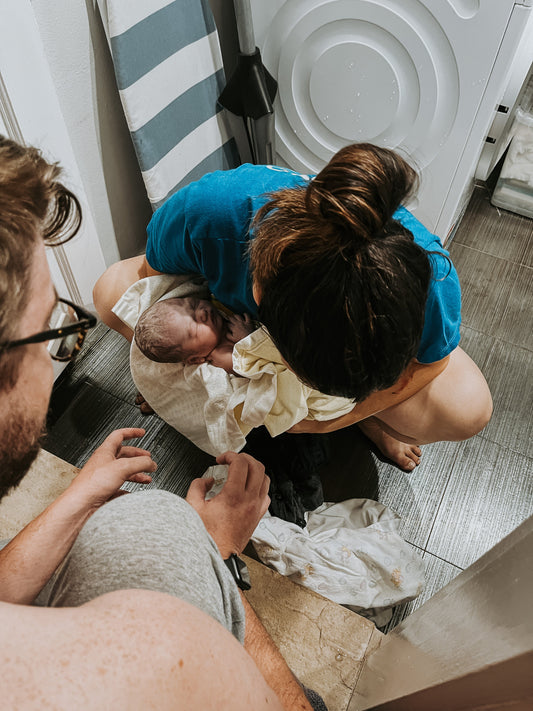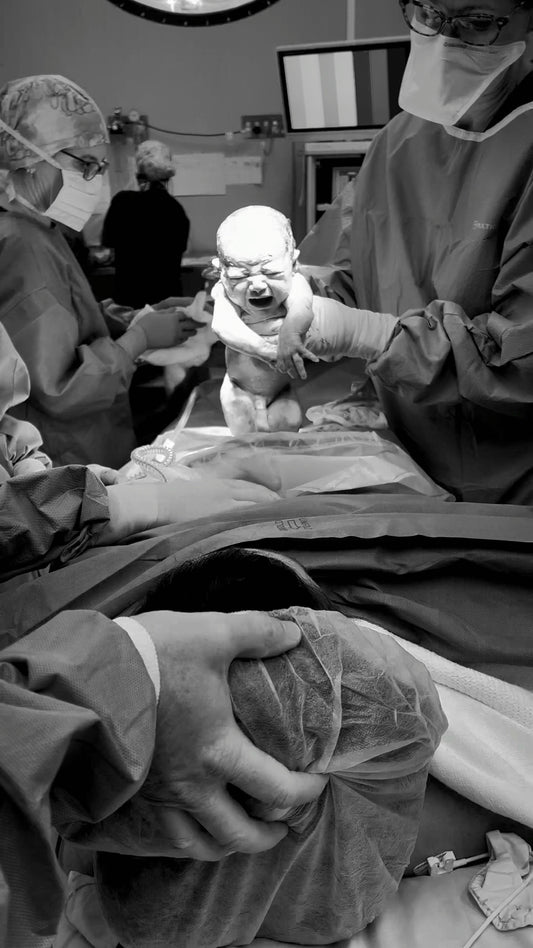My little guy, Wolf, 3.5 years, has just had surgery to remove his tonsils and adenoids, and I wanted to share with you all the journey to diagnosis, surgery and recovery. I hope it helps!

Signs we saw that prompted surgery:
- Enlarged tonsils: Wolf always had huge tonsils. They took up most of his throat with only the tiniest of gaps in between.
- Poor weight gain: Wolf would eat regularly but in very small amounts. He was being monitored for his weight as he weighed 12kg at 3.5 years. This can be a sign that there is an issue but makes sense as there was little space to comfortably swallow!

- Constant drooling and sickness: We thought Wolf was just a drooler, but then we started to notice excessive drooling was linked with red/ white pus on his tonsils. His little throat was so sore and inflamed that he could swallow his saliva. He was sick with these symptoms every 2 weeks, to the point he wouldn't even tell us his throat hurt as it had become his normal.
- Disturbed sleep: Wolf would not have restful sleep. He would toss and turn all night, wake up multiple times and never woke up refreshed. He would also snore and have times when he would hold his breath.
- Mouth breathing: Wolf began sleeping with his mouth open and was no longer breathing through his nose. Nose breathing is normal, but prolonged mouth breathing is not. Mouth breathing has long-term and serious consequences for little ones. Read more about mouth breathing and its impacts here.
Seeing an ENT
We initially saw a paediatrician about Wolf's constant sickness and weight. He picked up on Wolf's mouth breathing and referred him for bloods and also to an ENT - a specialist that specialises in Ear, Nose and Throat issues.
We saw the ENT, and Wolf was put on a nasal spray with instructions to spray, wait and watch. From the first appointment to surgery, it took 18 months after exhausting all other treatment options. The ENT advised at the appointment that he wouldn't have considered him for surgery any younger anyway. We were lucky to get a surgery date quickly due to a cancellation. We have private health insurance, and the public system has longer wait times for this surgery.
The wait to see an ENT can take a while, so be prepared for that. It can also be tricky to get your GP to give you a referral - as the impact of mouth breathing is not widely known. I have also heard a lot of parents mention that their concerns about mouth breathing and request for a referral were refused by their GP. Remember to go prepared when you see both the doctor when requesting a referral and when seeing the ENT. We suggest using the ISBAR tool so you can record everything and advocate for your little one.
Also, your dentist can refer you to an ENT. They look in the mouth and can quickly identify mouth breathing or issues that need to be addressed.
Questions to ask ENT if surgery is booked:
- What happens during the procedure (ENT can have different techniques for removal)
- Recovery time? How much time off care/ school/ work for you / swimming and normal activities?
- Pain relief protocol - make sure you get a script for a strong pain relief. If you dont use it, all good. But we didn't get one with Nahla, and it was a nightmare to try to get day 3 when she was in agony.
- Ask about pre-med and if it's needed. If your child is anxious prior to surgery, they can give them a medication to help settle them. Nahla had this, and Wolf didn't need it.
- Risk of surgery
What is T&A surgery?
Everyone has small glands on each side of the throat called tonsils and at the top of the throat behind the nose called adenoids. The body does not actually need so much tonsil and adenoid tissue. This means that your child will be perfectly healthy without their tonsils and adenoids. Tonsillectomy and adenoidectomy is a surgery to remove the tonsils and adenoids. It is a common paediatric surgery and as discussed above the surgery will be offered once other treatments have been tried for:
- Reoccuring throat infections
- Swallowing problems (often seen via signs of poor food intake and drooling)
- Sleep-disordered breathing (snoring, irritability, bedwetting, learning difficulties, slower growth) I talk about this more in a blog post I did on Nahla's sleep-disordered breathing that resulted in T&A surgery (and changed her life for the better!)
If you notice any of the symptoms listed, get your child assessed by an ENT specialist. They may suggest additional testing, like a sleep study, to confirm the diagnosis.
Preparing Wolf for Surgery
I was honest with Wolf and gave him an age-appropriate explanation 'we are going back to the hospital, the doctor will place a mask over your face, mummy will hold your hand and be right with you. When you wake up, your throat will be sore, but it will get better'.
We did a lot of medical play to help prepare him, and I highly recommend doing this.
What is Medical Play?
Getting your little one ready for the surgery should start well before the surgery date. Surgeries and going into hospitals, in general, can be a scary experience for anybody of all ages, so reassuring and preparing our little ones for this experience is important. A great way to do this is using medical play. This is a great way to help your child become familiar and comfortable with medical equipment and the hospital setting. I highly recommend getting a medical play set where they can explore the equipment in a relaxed situation and in their own time.


The experience of "going under" can be one of the scariest parts for little ones, especially when the mask is put over their face. Getting them familiar and comfortable with this can make the experience easier for them (and let's be honest for you too!) One of the ways to do this is using a mask like the breath of life mask because it's similar to the ones used in the hospital to administer the anaesthetic. Start by letting your child play and explore the mask themselves, demonstrate putting it on their favourite toy, and let them have a go putting it on too. As they become more familiar with the mask, ask them to put it over your mouth and then their own mouth. Wolf was so calm, only because we had done this so many times!
Research suggests that children benefit more from medical play when given time to play with the equipment and then process any emotional responses related to the experience.
Here are some other resources that you might find helpful for exposing your child to the idea of their surgery and going to the hospital.
Videos to watch together:
- Videos explaining what to expect from a child's point of view, such as - "A little deep sleep"
- RCH has also made a collection of videos for children about being in hospital
- A Sleepy Tale: My First Surgery by Jennifer Maziad
- S is for Surgery: A Kids Surgery Book from A - Z by Dylan Fox
Preparation for surgery
Your surgeon should provide you with a list of recommended things to bring into the surgery. They will advise on the fasting timeframe. This is extremely important to follow!

Here are some things that I packed specifically for Wolf and me for our overnight stay:
- His own pillow and blanket - to make his hospital room feel more like home
- Favourite toys and distraction items like colouring books, iPad, and books
- A snack pack of his favourite foods that are soft and won't hurt
- Airpods - so noisy at night (for you)
- Slippers
- If you can get dropped and picked up, I highly recommend organising that, as you get zero sleep that first night
The surgery and recovery ward
One of the toughest things I have ever done is watching my sweet boy go under and then having to walk out and leave him alone in there with the medical team. It's heartbreaking.
Being prepared for what will happen will help you prepare yourself for the emotional journey you no doubt will face. It's quite fast-paced as they need to get them under quickly without causing them concern or upset. It feels stressful, but let me talk you through the steps so you know what to expect:
- Your little one will be wheeled in
- You will help transfer them onto the operating table.
- You will be asked to stand by your child, hold their hand, comfort, chat and distract them.
- They will place a mask over your child's face. This is where you can expect your little one to get upset and start to worry - put that brave face on. Don't let them sense your sadness, and shower them with love and reassurance.
- Within about 30 seconds, your little one will start to become zonked. They may tense up, strain and become rigid - this is the body's normal response to going under
- You will now be directed to kiss your little love on the head and then walk out, leaving them in the hands of the medical team - this is so tough, tears are so normal (you've got this)
The surgery takes between 30- 60 minutes, but your little one might be away from you for up to 2 hours in total. You will wait in the waiting area, and the surgeon will come out and brief you after the surgery 99% of the time, saying, 'everything went perfectly'.
Your child will be in recovery until they wake from the anaesthetic, and then they will bring you through. The way little ones wake up can vary so much. Nahla was really drowsy, had no tears, and just slept for the next 4 hours on me. Wolf, however, was really upset. He was delusional and trying to climb off the bed. This was awful to see. He was in pain and disorientated. I climbed up onto the bed, placed him on me and cuddled him.

The first night in hospital was tough. He was in pain. He hardly slept and was really difficult to console. Prepare yourself for a sleepless night and ask the nursing staff for help or extra pain relief if you feel your little one needs it. I had to advocate for stronger medication than panadol for Wolf, and I'm so glad I did.
Care at home
The recovery time is approximately 10 -14 days, and for us, it was tough! Prepare for a wakeful night, a little one in pain and an emotional rollercoaster.
Here is a video of how I prepared for his first night at home (day 2)
Day 2:@tinyheartseducation My little boy had his tonsils removed for constant infections, very disturbed sleep and mouth breathing due to a compromised airway from enlarged tonsils. This is what ive got on hand for his first night at home. He is sleeping next to me so I can keep a close eye on him ❤️🩹 #tonsilectomyrecovery ♬ original sound - Tiny Hearts
- Needed to stay on top of pain relief
- Ice chips are a lifesaver. We had them on constant rotation
- He didn't eat much at all, and hydration was the focus
- No rules applied (iPad all day, bedtime was midnight)
- He woke 5 times this first night and slept in our bed
Day 3:
- Tough day!!!
- He refused medication, so the pain was bad, and he was difficult to console
- We did baths and showers on repeat
- Ice chips all day. He didn't eat
- The night was actually decent, with only 3 wakes
Day 4:
- Felt like he had turned a corner!
- He was much happier.
- Bed all day with iPad
- Ate chicken noodle soup, jelly and custard
- Night was TERRIBLE
Day 5:
- This was another really tough day!
- He went for his review with the surgeon, who confirmed that day 5 is when scabs start to fall off, so pain increases again.
- He was in the shower or bath most of the day and was very upset.
- Ice chips on repeat, no food
- By this day, we'd been having sleepless nights and constantly attending to him. It was emotionally tough for us all. Chris and I tag-teamed a nap each, which helped!
Day 6-10:
- He began improving slowly each day from here
- He was in bed most of the day unless he was in the shower
- He started eating more food

My top tips for surviving those days at home:
- Make a recovery goodie box. Fill it with things that will keep them entertained and excited for the next 14 days at home, like books, movies, and toys. Prepare downtime activities like Play-Doh, colouring books, markers, crayons, stickers, DVDs, books, and games.
- Have iced water ready in the car for the drive home. Icy drinks can help numb and soothe the pain in their mouth. Put ice into an insulated cup before the surgery, and it will be ready for the car ride home.
- Ice chips need to be in the freezer (if not part of your fridge). These were a game changer.
- Either have them in your bed or you go in their bed. They need closeness and comfort.
- Set an alarm on your phone for when your child is next due for pain medication. With so much going on, it's really easy to forget.
- Wrap a present that they get to open after the surgery - it gives them something to look forward to

- Prepare the medications before the night so you know you have the right amount, and put it into a container labelled with the medication.
- Use a medication tracker so that you and your partner are aware of what has been given, how much, and when
- If your little one is refusing medication, see our tips and tricks here or consider suppository
- Be familiar with the recovery timeline, and know which days are expected to get worse.
Foods Wolf ate:
Leading up to the surgery, it is a good idea to think about preparing food and drinks your little one can have after the surgery. The recommendation after a T&A surgery is to have soft, liquid foods for the first few days. Most kids will prefer chilled or icy drinks and food as they can help numb their mouth's pain.
Wolf didn't eat alot until around day 6. Remember, this is ok, but hydration is key! I took Wolf out before surgery, and we bought a special Mario cup. This helped get fluid into him.
Avoid these foods:
Red food: red liquids like red juices or even red-coloured jelly. You will need to be monitoring for signs of bleeding post-surgery, and red foods and drinks can make it more difficult to tell.
Sharp, spicy or hard foods: like chips or toast. These foods can scrape the scabs in the back of the throat and make them bleed.
He liked:
- Mashed potato
- Chicken noodle soup
- 7/11 slurpy
- Ice cream and icy poles
- Custard
- Jelly
- Up and go
When to see a doctor, red flags after the surgery
- if bleeding from the nose or throat
- if the pain is not being controlled with the medication given by your doctor.
- vomiting more than four times within the first 24 hours after the surgery
- your child isn't able to drink at all
- your child develops a fever

Update on Wolf post-surgery
Wolf is now 22 days post-surgery. We made it! I am not going to lie. That was an extremely tough 10 days. I am so glad to report that we have already seen changes that are making those days a distant memory and all worth it.
Sleep: Wolf now sleeps with minimal tossing and turning. He wakes happy and is no longer overtired and grumpy. He is not snoring or holding his breath.
Mouth breathing: Wolf now breathes through his nose. His mouth is still slightly open, but we will now work with a specialist to start oral myofunctional therapy to ensure we continue to get the best results for our little boy.
Weight: He is eating like crazy! He eats double the amount and has put on a 1kg since surgery!!!
Talking: He talks so much more now. It must be because it's not painful! His voice is clear and so adorable. We didn't realise how muffled it was beforehand.
We considered surgery carefully and weighed up the pros and cons, but 22 days later, I already can tell this was absolutely the best thing for him, and I know we will only see more and more benefits as time goes on.
If your little one is going through a T&A, I urge you to make sure you take care of yourself, ask for support when needed, and just know that the end is in sight. Make sure you book annual leave for the time so you can be present and with your little one 100%. They need you.
So much love, good luck!
Nik xx







